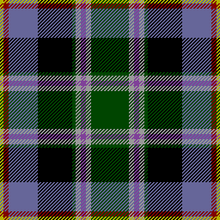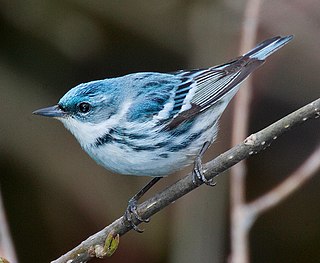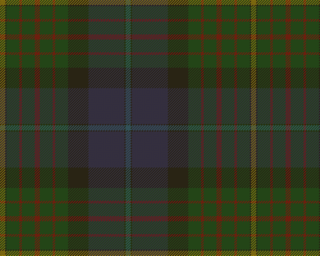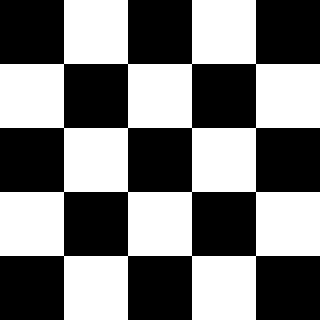
The Colorado state tartan is the Scottish-style tartan pattern officially adopted by the US State of Colorado to represent the state in various functions and occasions.

The Colorado state tartan is the Scottish-style tartan pattern officially adopted by the US State of Colorado to represent the state in various functions and occasions.
The Colorado General Assembly adopted House Joint Resolution 97-1016 [1] on March 3, 1997, designating an official Colorado state tartan. The tartan is a pattern and colors that symbolize Colorado's splendor and history. The pattern or sett consists of primary blocks of forest green and cerulean blue separated by broad dividing bands of black, with the forest green checks containing two pairs of tram tracks consisting of lavender and white and with the cerulean blue checks containing a gold stripe with red guard lines. The official state tartan is a district tartan, which may be worn by anyone.
The Colorado state tartan thread count as recorded by the Scottish Tartans Authority (and thus also by the Scottish Register of Tartans which subsumed the STA records):
[Y/8] R6 MB34 K40 G4 W6 Lv6 W6 [G/64]
Colorado House Joint Resolution 96-1014 designated July 1 as Tartan Day in the State of Colorado.

A kilt is a garment resembling a wrap-around knee-length cloth, made of twill-woven worsted wool with heavy pleats at the sides and back and traditionally a tartan pattern. Originating in the Scottish Highland dress for men, it is first recorded in the 16th century as the great kilt, a full-length garment whose upper half could be worn as a cloak. The small kilt or modern kilt emerged in the 18th century, and is essentially the bottom half of the great kilt. Since the 19th century, it has become associated with the wider culture of Scotland, and more broadly with Gaelic or Celtic heritage.

Tartan is a patterned cloth with crossing horizontal and vertical bands in multiple colours, forming simple or complex rectangular patterns. Tartans originated in woven wool, but are now made in other materials. Tartan is particularly associated with Scotland, and Scottish kilts almost always have tartan patterns.

The cerulean warbler is a small songbird in the family Parulidae. It is a long-distance migrant, breeding in eastern North American hardwood forests. In the non-breeding season, it winters on the eastern slope of the Andes in South America, preferring subtropical forests.

Tartan Day is celebration of Scottish heritage and the cultural contributions of Scottish and Scottish-diaspora figures of history. The name refers to tartan, a patterned woollen cloth associated with Scotland. The event originated in Nova Scotia, Canada, in 1987. It spread to other communities of the Scottish diaspora and Scotland itself in the 1990s to 2000s.
Cerulean, also spelled caerulean, is a variety of the hue of blue that may range from a light azure blue to a more intense sky blue, and may be mixed as well with the hue of green. The first recorded use of cerulean as a colour name in English was in 1590. The word is derived from the Latin word caeruleus, "dark blue, blue, or blue-green", which in turn probably derives from caerulum, diminutive of caelum, "heaven, sky".

The California state tartan is the official Scottish Tartan pattern of California, created July 23, 2001 and defined under law in California Government Code § 424.3(a). California State Assembly Member Helen MacLeod Thomson wrote the law. The tartan was designed by J. Howard Standing of Tarzana, California, and Thomas Ferguson, Sydney, British Columbia. Any resident of the state may claim the tartan and the design as described in state law states that the tartan is a pattern or sett consisting of alternate squares of meadow-green and Pacific blue that are separated and surrounded by narrow charcoal bands. The squares of meadow-green are divided by a gold seam that is supported by charcoal lines on each side. There are three redwood stripes, the middle of which is broader, that are added to each side of the gold seam. The Pacific blue square is divided by a sky-blue stripe, which is supported on each side by charcoal lines.

Clan MacLennan, also known as Siol Ghillinnein, is a Highland Scottish clan which historically populated lands in the north-west of Scotland. The surname MacLennan in Scottish Gaelic is Mac Gille Fhinnein, meaning the son of the follower of St Finnan.

The uniforms of the United States Air Force are the standardized military uniforms worn by members of the United States Air Force to distinguish themselves from the other services.

Border tartan, sometimes known as Borders tartan, Northumbrian tartan, Northumberland tartan, shepherds' plaid, shepherds' check, Border drab, or Border check, is a design used in woven fabrics historically associated with the Anglo-Scottish Border, particularly with the Scottish Borders and Northumberland. Possibly the most identifiable Border tartan garment of the region is the maud, made popular from the 1820s by fashionable Border Scots such as Sir Walter Scott, James Hogg, Henry Scott Riddell and Robert Burns.

Check is a pattern of modified stripes consisting of crossed horizontal and vertical lines which form squares. The pattern typically contains two colours where a single checker is surrounded on all four sides by a checker of a different colour.

Sillitoe tartan is a distinctive chequered pattern, usually black-and-white or blue-and-white, which was originally associated with the police in Scotland. It later gained widespread use in the rest of the United Kingdom and overseas, notably in Australia and New Zealand, as well as Chicago and Pittsburgh in the United States. It is used occasionally elsewhere, including by some Spanish municipal police and in parts of Canada, where it is limited to auxiliary police services.
The uniforms of the United States Army distinguish soldiers from other service members. U.S. Army uniform designs have historically been influenced by British and French military traditions, as well as contemporary U.S. civilian fashion trends. The two primary uniforms of the modern U.S. Army are the Army Combat Uniform, used in operational environments, and the Army Green Service Uniform, worn during everyday professional wear and during formal and ceremonial occasions that do not warrant the wear of the more formal blue service uniform.
The symbols of Queensland represent the Australian state of Queensland and the Queensland Government. The different symbols and emblems represent both the state and the government. The official state emblems of Queensland are prescribed in the Emblems of Queensland Act 2005.

The Washington state tartan is the official state tartan established by the Washington state legislature.

The United States Coast Guard Pipe Band is a pipe band and private military unit composed of current and former United States Coast Guard personnel. Though a privately maintained entity, it is formally recognized by the U.S. Coast Guard and provides support to official Coast Guard ceremonies including changes-of-command, funerals, and ship commissioning. The unit was established in 2001 and formally recognized by the U.S. Coast Guard as a Coast Guard-affiliated organization the following year.

District tartans for the Commonwealth of Australia and for each of its constituent States have been registered in the Scottish Register of Tartans (SRT). Additionally, fashion tartans covering either Australia as a whole, or its capital city, Canberra, have been registered in the SRT, as have district tartans in respect of some of Australia's local government areas.

Regimental tartans are tartan patterns used in military uniforms, possibly originally by some militias of Scottish clans, certainly later by some of the Independent Highland Companies (IHCs) raised by the British government, then by the Highland regiments and many Lowland regiments of the British Army, and eventually by some military units in other countries. The earliest evidence suggesting militia uniform tartans dates to 1691, and the first certain uniform tartan was that of the Royal Company of Archers in 1713. The IHCs raised 1725–29 by the British government appear to have had one or more uniform tartans, though some later ones did not. The first true Highland regiment of the British Army was the 42nd Regiment of Foot formed by amalgamation of the IHCs in 1739, and had its own consistent uniform tartan by 1749 or 1757 at the latest. Some later Highland units also wore this tartan, while others developed minor variations on it, usually by adding bright-coloured over-checks. Some few regiments developed their own tartans not based on Black Watch, including the 75th, 79th, Fraser Fencibles, and Loyal Clan Donnachie Volunteers. Some units developed special tartans for bandsmen and grenadiers.